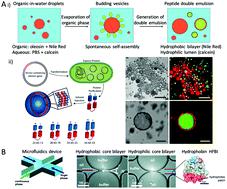当前位置:
X-MOL 学术
›
Soft Matter
›
论文详情
Our official English website, www.x-mol.net, welcomes your
feedback! (Note: you will need to create a separate account there.)
In search of a novel chassis material for synthetic cells: emergence of synthetic peptide compartment
Soft Matter ( IF 2.9 ) Pub Date : 2020-11-06 , DOI: 10.1039/d0sm01644f Bineet Sharma 1 , Yutao Ma , Andrew L Ferguson , Allen P Liu
Soft Matter ( IF 2.9 ) Pub Date : 2020-11-06 , DOI: 10.1039/d0sm01644f Bineet Sharma 1 , Yutao Ma , Andrew L Ferguson , Allen P Liu
Affiliation

|
Giant lipid vesicles have been used extensively as a synthetic cell model to recapitulate various life-like processes, including in vitro protein synthesis, DNA replication, and cytoskeleton organization. Cell-sized lipid vesicles are mechanically fragile in nature and prone to rupture due to osmotic stress, which limits their usability. Recently, peptide vesicles have been introduced as a synthetic cell model that would potentially overcome the aforementioned limitations. Peptide vesicles are robust, reasonably more stable than lipid vesicles and can withstand harsh conditions including pH, thermal, and osmotic variations. This mini-review summarizes the current state-of-the-art in the design, engineering, and realization of peptide-based chassis materials, including both experimental and computational work. We present an outlook for simulation-aided and data-driven design and experimental realization of engineered and multifunctional synthetic cells.
中文翻译:

在寻找用于合成细胞的新型底盘材料:合成肽区室的出现
巨脂囊泡已经被广泛地用作合成细胞模型概括栩栩如生处理的各种,包括体外蛋白质合成,DNA复制和细胞骨架组织。细胞大小的脂质囊泡本质上是机械脆弱的,并且由于渗透压而易于破裂,这限制了它们的可用性。近来,肽囊泡已经被引入作为合成细胞模型,其可能克服上述限制。肽囊泡比脂质囊泡更坚固,更稳定,并且可以承受苛刻的条件,包括pH值,热和渗透变化。这份小型回顾总结了基于肽的底盘材料的设计,工程和实现方面的最新技术,包括实验和计算工作。我们提出了工程辅助和多功能合成电池的仿真辅助和数据驱动设计以及实验实现的前景。
更新日期:2020-11-12
中文翻译:

在寻找用于合成细胞的新型底盘材料:合成肽区室的出现
巨脂囊泡已经被广泛地用作合成细胞模型概括栩栩如生处理的各种,包括体外蛋白质合成,DNA复制和细胞骨架组织。细胞大小的脂质囊泡本质上是机械脆弱的,并且由于渗透压而易于破裂,这限制了它们的可用性。近来,肽囊泡已经被引入作为合成细胞模型,其可能克服上述限制。肽囊泡比脂质囊泡更坚固,更稳定,并且可以承受苛刻的条件,包括pH值,热和渗透变化。这份小型回顾总结了基于肽的底盘材料的设计,工程和实现方面的最新技术,包括实验和计算工作。我们提出了工程辅助和多功能合成电池的仿真辅助和数据驱动设计以及实验实现的前景。











































 京公网安备 11010802027423号
京公网安备 11010802027423号